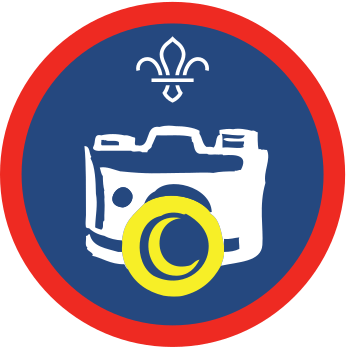Light painting
You’ll need
- Camera or phone
- Torch or phone
- Tripod (optional)
Before you begin
- Use the safety checklist to help you plan and risk assess your activity. Additional help to carry out your risk assessment, including examples can be found here. Don’t forget to make sure all young people and adults involved in the activity know how to take part safely.
- Make sure you’ll have enough adult helpers. You may need some parents and carers to help out if you’re short on helpers.
- Ask everyone to come along wearing dark clothes. Let them know that it’ll be helpful if they can bring some of their own equipment too.
- Check that you’ve got parents and carers’ permission to share any photos you take during the session.
- Use your camera in ‘manual’ mode. This gives you full control of all the different settings when you’re taking photos.
- Shutter speed is how long your camera spends taking a photo. It measures the length of time your camera shutter is open so light can reach the sensor. Set your shutter speed to somewhere between 10 and 30 seconds. You may need to try different times depending on what you’re painting – a longer word will take longer to write, for example.
- ISO is a setting that can brighten or darken a photo; the higher the number, the brighter the photo. It used to measure film sensitivity, but it’s been adapted for digital cameras. For this activity, you’ll need to use ISO 100.
- The aperture is like the pupil of your camera lens. Just like the pupil in your eye, it can open or shrink to change how much light gets through. It’s measured as a fraction and you should set it between f/8 and f/22.
- When you’re taking photos, you should manually focus the camera first. On some cameras, you can do this by half pressing down the shutter button before you take the photo.
- It’s a good idea to use a tripod too, or rest the camera on a table so that it won’t move during the time you’ll be taking your photos – it could be up to 30 seconds.
- On most Android phones, you can set the camera app to ‘manual’ or ‘pro’ mode by swiping left or right when using the camera. This mode will let you control settings like exposure, ISO, and shutter speed in a similar way to a digital camera above.
- If you’re using an iPhone that can take ‘live photos’, make sure the setting is turned on in your camera app. Set the timer on your phone and take a photo. After you’ve taken the photo, you can edit it to apply the ‘long exposure’ effect. It might take a few tries to get your timing right with this method.
- You can also download a camera app that will let you control the camera settings. This can make it easier to take long exposure photos. for example ProCam X or Camera FV-5
- If you’re using a smartphone as the torch for your light painting, you may be able to download apps that can change the colour of the light on your phone.
- Like with a digital camera, it’s a good idea to use a tripod to keep your phone steady while you’re taking the photos.
Take some photos
- The person using the camera should set it up to take long exposure photos.
- Everyone should work together to decide where they’ll take their photos, frame the scene, and set up a tripod (if they have one). They should try to eliminate as much light as possible from their scene, for example, by avoiding standing directly under street lights.
- Everyone should split into small groups or pairs to plan their ideas for their light painting.
- Each group should get into a space to chat about and practise their light painting ideas.
- When they’re ready, everyone should take it in turns to take their photos. One group at a time should move into the photo space and spend a couple of minutes trying out their light painting ideas with the camera. They could use a torch, head torch, or light on a smartphone as a light source.
- Once all of the groups have had a go, everyone should show off the photos. If there’s time, they could try out some different ideas or camera settings.
Lighting ideas
Once you’ve got the hang of the basics, try some different techniques and torches and see what everyone can create. We’ve come up with a few ideas to help get you started:
- If you’re painting words, you’ll need to write them backwards: if you’re facing the camera, write from right to left so that they come out the right way around on the photo. Don’t worry if you forget or find it too tricky – you can always flip the photo post production.
- If you’re painting letters, it can help to use a flat surface like the ground or a big log to write on. Use your body as a guide to try and make sure they’re all the same size.
- Try taping some string lights to a stick to make your own light bar and create different patterns.
- You can include people in your photos if they stand still in your scene. Use a second light source to light up your subject so that you can see them clearly. If you’re using a smartphone, try taking a screenshot of a plain white page to use to light up your subject, instead of using the smartphone torch.
- You can include spooky transparent figures by asking someone to stand still in the frame for a few seconds, then quickly move out of the scene.
- If it’s really dark, you could ask someone to pose in front of the camera and use torches to light them up from behind – this will create a light silhouette outline of their pose.
Reflection
This activity was a great chance to get creative and try something new. Did anyone learn any new skills in the session? Perhaps people learned more about how a camera works or picked up some tips for taking photos in the dark. Many people take lots of photos every day, but they may not have stopped to think about the different settings they can use or how to adjust their camera before.
Everyone also got to spend some time with their friends and have fun. Everyone should take it in turns to share the things that they enjoyed the most about the session. You could challenge everyone to take some more photos in their own time or try to work together to spell out a positive message to share.
Safety
All activities must be safely managed. You must complete a thorough risk assessment and take appropriate steps to reduce risk. Use the safety checklist to help you plan and risk assess your activity. Always get approval for the activity, and have suitable supervision and an InTouch process.
- Dark
Provide some light, so the environment isn’t completely dark. Everyone must be able to see others and move around the area safely.
- Phones and cameras
Make sure parents and carers are aware and have given consent for photography.
- You can change the style of photo, use different colours or camera settings, or try challenging everyone to draw the Scout logo or see who can write the longest word! You could share some of the images on social media as long as you have the right permissions.
- If everyone enjoyed the activity, why not run a competition with the group and see who can take the best photo at home?
- If people don’t want to be in the photos, they could help to set up the camera and equipment, direct others, and take the photos.
- Think about the space you’ll be in and the equipment you’re using in advance to make sure it’s accessible to everyone in the group.
All Scout activities should be inclusive and accessible.
Why not work towards the Scouts Photographer Activity Badge and discuss things like focus, exposure control, and flash settings in more detail? You could use what everyone learned about light painting with long exposure photography to explain the impact of shutter speed and aperture size on an image.


